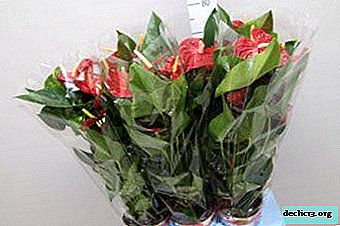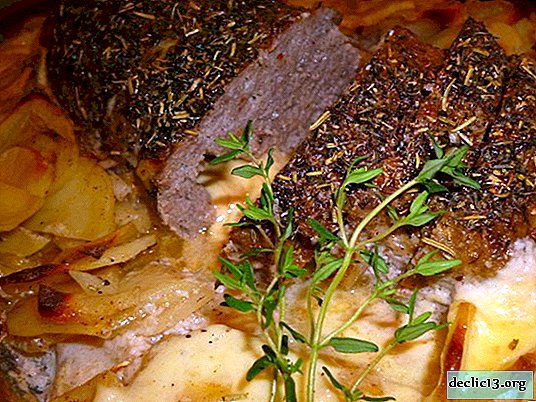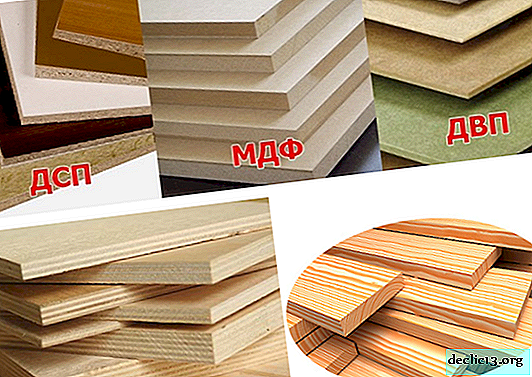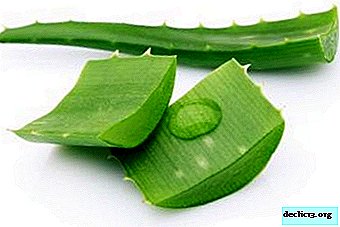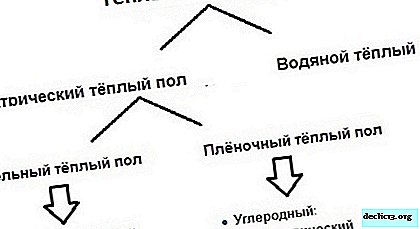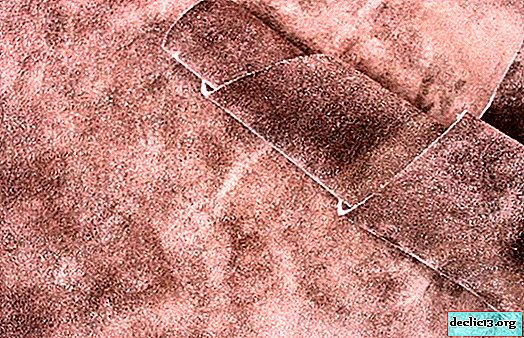The best tips and instructions for propagating cyclamen by dividing the tuber
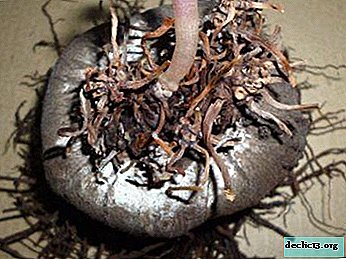
Growing cyclamen, at some point almost all flower growers come to the decision to propagate the plant for more magnificent home decoration or in order to create an exclusive gift for the celebration. Cyclamen is a beautiful domesticated flower, which, like all plants that came to us from the warm edges of the plant, has its own characteristics of reproduction.
Strict adherence to cyclamen breeding rules will largely determine the success of the entire enterprise and make it possible to effectively increase the size of this handsome man.
What it is?
The homeland of cyclamens is the territory of the Mediterranean and North Africa. You can find cyclamens in Cyprus and Palestine, in Iran, in alpine meadows and in Greece. It belongs to the Mirsin group, and also belongs to primroses. The flower has many varieties, almost 70, they vary in size, flower characteristics, colorization. About twenty species of cyclamen are domesticated, have taken root well and grow in apartments.
The height of the plant can be from 15 cm to 35 cm. The root of its tuberous type resembles a flattened bulb dotted with small buds. The diameter of the cyclamen tuber is 4-15 cm. The foliage is light or dark green in color, can have patterns-stains and spots of light gray.
Peduncles are long, strong, of small thickness, covered in abundance with flowers, up to sixty buds can be opened on one cyclamen. The flowers themselves are small, slightly inclined downward, with slightly bent petals. They look like butterflies soaring above a clearing.
On a note. The plant is hermaphrodite, and after flowering, the tuber is partially exposed, about a quarter or a third crawls out of the soil.There are a lot of varieties and types of plants, for example, Persian, cyclamen Mix and others (more about cyclamen Mix can be found in this material).
Ways
How to share a flower? If the seed reproduction of cyclamen is very complex, requires a lot of time and effort, then propagation by leaf cuttings, rosettes and division of the tuber - much easier and is guaranteed to pass the parameters of the mother plant to the next generation.
Rosettes
 Cyclamen rosettes are shoots on the root bulb, developing from the kidneys, which are literally strewn with a nodule. Of course, not all of them wake up and shoot, as a rule, there are only a few of them. In the old cyclamen, shoots grow quite long, professional flower growers even came up with a special name for them - horns.
Cyclamen rosettes are shoots on the root bulb, developing from the kidneys, which are literally strewn with a nodule. Of course, not all of them wake up and shoot, as a rule, there are only a few of them. In the old cyclamen, shoots grow quite long, professional flower growers even came up with a special name for them - horns.
For breeding purpose one of the developed shoots is separated from the tuber, twisting it like literally with meatbut very carefully. After separation, the shoot is transplanted into moist soil, which is usually taken for growing cyclamens and a greenhouse is organized. To do this, use a glass jar or a plastic bottle with a cropped bottom, or a plastic bag.
The greenhouse should be made of a completely transparent material. The plant is not covered tightly, the usual temperature regime of 20-25 degrees is observed.
Reference. After two to three weeks, roots should form. After this, the greenhouse is cleaned and looked after cyclamen as usual. He begins to increase leaf mass and creates a nodule.Kids
How to share the kids? Usually when transplanting cyclamens into new soil, in the middle or at the end of summer, they extract new planting material, taking additional nodules from the tuberthat form on the surface of the mother tuber.
- The healthiest minituber baby is chosen, its signs are the lack of wrinkling on the surface, and there must be a kidney at the top of the nodule.
- The newborn onion is carefully separated with a large tuber and rooted in a small glass in a regular substrate, putting on an improvised greenhouse for a week or two.
- After the first leaves have sprouted, the greenhouse is cleaned and looked after like an ordinary plant.
- After the appearance of several leaves, the seedling is moved to a permanent place of residence - in a pot.
- After a month, they are fertilized with the usual cyclamen drug, only the solution is weaker, feeding in the future according to the usual rules.
From leaflets
Leaf cuttings of cyclamen have the peculiarity that rooting in water does not occur, and rooting in the substrate is not always successful. This method is used only for the European species. They choose leaflets with small roots, so for a Persian species that does not have one, the method will be ineffective (more about the Persian look and how to care for it can be read in this material, but how to distinguish it from the European one can be found here).
The leaf is not cut, but is necessarily broken off with a small tuber fragment. It turns out that at the end of the petiole there is something like shoots, strings, these are mini-roots, they will allow the leaf to take root and develop as an independent plant. Call them "fingers." Such a fragment is planted in the soil and covered with a greenhouse until rooting, then it is removed and taken care of as usual. More details about the propagation of cyclamen leaves can be found here.
Seeds
Basically, the method is used for the Persian variety:
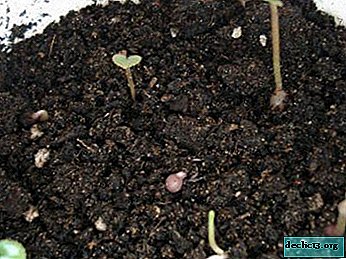 Before sowing, the seed material is soaked in a biostimulating solution for eight hours, and then sown in peat-sand soil, previously sanitized by calcination.
Before sowing, the seed material is soaked in a biostimulating solution for eight hours, and then sown in peat-sand soil, previously sanitized by calcination.- Immerse the seed to a depth of about a centimeter, watering the hole a little before sowing. The main condition for germination is darkness, because the container is covered with a black film. Make regular airing and moisturize, preventing the soil from drying out.
- After 30-45 days, seedlings hatch and remove the film, open the container for proper lighting. The optimum temperature for the development of seeds and seedlings is 18 degrees.
- After the development of 2-3 leaves make a pick, completely covering the small nodules with a soil mixture.
- Six months later, they plant in pots, leaving the tuber one third above the surface of the earth.
Seedlings bloom in a year and a half.
More information about growing cyclamen from seeds can be found in this material.
Tuber division propagation
Cyclamen tuber is the most important and most vulnerable part of it. Division by cutting a tuber is an extreme procedure, which is likely to lead to rotting of the division or death of the mother plant, and possibly to both immediately.
If we are talking about the tuberous topic of reproduction, then it is preferable to still use the division of children. Nevertheless, we consider the propagation of cyclamen by division of the root. Here you need to consider that the option is suitable only for very large, overgrown cyclamens.
Important! It is necessary to choose the right time for division. It is possible to expose a tuber to this process only during the rest period.Detailed instructions
Training
- Water the plant per day so that the soil is moistened, and it would be possible to extract the onion without interruption.
- Undermine the tuber, wash with standing water at room temperature, removing the ground.
- Take a very sharp knife with a thin blade.
- Sanitize it.
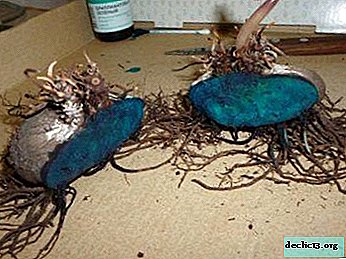 To minimize the traumatic effect, it is better to divide the tuber no more than a couple of parts. The maximum allowed division into four divisions.
To minimize the traumatic effect, it is better to divide the tuber no more than a couple of parts. The maximum allowed division into four divisions.- The incision must be made in such a way that each part has at least one growth point and a “heel” from which thin roots branch.
- Leave to dry for 2-4 hours.
- Powder bare parts with charcoal powder. Some use greens before coal treatment. Leave for another 18 hours to dry.
Soil requirements
The soil should contain a leaf part, peat, humus and sand. You can buy ready-made soil. It is important to steam or freeze it for the purpose of disinfection, and you can shed it with a weak solution of manganese. A drainage layer is also required; it is disinfected by baking in the oven.
Disembarkation
- Pour drainage into the pot, a centimeter and a half.
- Cover almost the entire volume of the vessel with soil from above.
- Moisten a little.
- Place the divider in the center. When planting, you can not deepen it.
- Add another layer of soil.
- Plant in moist soil.
Pot
The pot is taken about 7-8 cm in diameter, always with holes on the bottom to drain excess water.
Home Care
The rules for plant care apply the same as usual.
- Watering. Watering in the future is done extremely carefully so that the divide does not rot. It is recommended to water the edge of the pot. Alternate upper and lower irrigation. Watering is done from below, pouring water into the pan after the soil dries.
 Lighting. Cyclamen needs proper lighting with diffused sunlight. He does not tolerate direct lighting.
Lighting. Cyclamen needs proper lighting with diffused sunlight. He does not tolerate direct lighting.- Temperature. A lover of coolness, does not tolerate being near a battery or stove. A temperature of up to 20 degrees is suitable, but 14-17 degrees will be optimal.
- Air humidity. Excessive dryness will be detrimental, and direct spraying with water is not recommended. It is better to place cups of water or an evaporator next to the pot.
- Make-up. To carry out the first bait, they wait until the sprouts appear. Basically, they try to start feeding after six months. At first, do not use nitrogen recharge. Liquid flower formulations are diluted in half a cap per liter volume of water.Note! At the same time, the solution should not be allowed to fall on leaves and stems.
Excess mineral fertilizers are harmful to cyclamen, they must be used very sparingly. First, the soil is watered, waiting for the complete absorption of water, and only then make recharge.
Conclusion
As it turned out, the rules for breeding cyclamen are not so complicated, and if laziness or carelessness does not interfere, even a beginner grower can get new flowers. Timeliness and sequence of plant care is the key to the proper and healthy development of a newborn plant, its abundant and long flowering.

 Before sowing, the seed material is soaked in a biostimulating solution for eight hours, and then sown in peat-sand soil, previously sanitized by calcination.
Before sowing, the seed material is soaked in a biostimulating solution for eight hours, and then sown in peat-sand soil, previously sanitized by calcination. To minimize the traumatic effect, it is better to divide the tuber no more than a couple of parts. The maximum allowed division into four divisions.
To minimize the traumatic effect, it is better to divide the tuber no more than a couple of parts. The maximum allowed division into four divisions. Lighting. Cyclamen needs proper lighting with diffused sunlight. He does not tolerate direct lighting.
Lighting. Cyclamen needs proper lighting with diffused sunlight. He does not tolerate direct lighting.